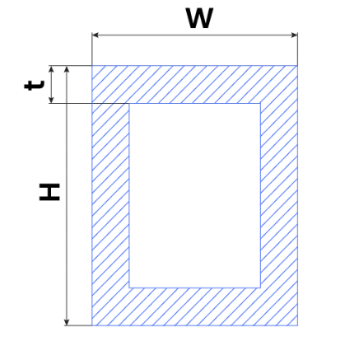1. What is the Cross-Sectional Area Calculator?
Definition: This calculator computes the cross-sectional area of various shapes based on their defining dimensions.
Purpose: It assists in engineering and structural analysis by calculating the area of cross-sections, useful in material science, mechanics, and design.
2. How Does the Calculator Work?
The calculator uses the following formula for the selected shape:
| Section |
Area |
| Hollow Rectangle |
(H × W) - ((W - 2t₁) × (W - 2t₂)) |
| Rectangle |
W × H |
| I |
2 × W × t₁ + (H - 2 × t₁) × t₂ |
| C |
2 × W × t₁ + (H - 2 × t₁) × t₂ |
| T |
W × t₁ + (H - t₁) × t₂ |
| L |
W × t + (H - t) × t |
| Isosceles Triangle |
0.5 × B × H |
| Equilateral Triangle |
0.4330 × l² |
| Circle |
0.25 × π × D² |
| Tube |
0.25 × π × (D² - (D - 2 × t)²) |
Steps:
- Select the shape from the dropdown menu.
- Enter the required dimensions for the selected shape along with their units (mm, cm, m, in, ft, or yd).
- Convert all inputs to meters for calculation.
- Compute the cross-sectional area in square meters based on the shape-specific formula.
- Convert the area to the selected output unit (mm², cm², m², in², ft², or yd²).
- Display the result, formatted in scientific notation if the absolute value is less than 0.001, otherwise with 4 decimal places.
3. Importance of Cross-Sectional Area Calculations
Calculating cross-sectional areas is essential for:
Engineering: Determining material strength and load-bearing capacity.
Mechanics: Analyzing stress and strain in structural components.
Design: Optimizing shapes for efficiency in construction and manufacturing.
Education: Understanding geometric properties in applied mathematics.
4. Using the Calculator
Example 1 (Hollow Rectangle): Calculate the cross-sectional area:
- Height: \( H = 10 \, \text{cm} \);
- Width: \( W = 8 \, \text{cm} \);
- Thickness: \( t = 1 \, \text{cm} \);
- Output Unit: Square Centimeters (cm²);
- Convert to meters: \( H = 0.1 \, \text{m} \), \( W = 0.08 \, \text{m} \), \( t = 0.01 \, \text{m} \);
- Convert to cm²: \( A = 0.0032 \times 10,000 = 32 \, \text{cm}^2 \);
- Result: \( A = 32.0000 \, \text{cm}^2 \).
Example 2 (Circle): Calculate the cross-sectional area:
- Diameter: \( D = 4 \, \text{in} \);
- Output Unit: Square Inches (in²);
- Convert to meters: \( D = 4 \times 0.0254 = 0.1016 \, \text{m} \);
- Area in m²: \( A = 0.25 \times \pi \times D^2 = 0.25 \times \pi \times (0.1016)^2 \approx 0.008107 \, \text{m}^2 \);
- Convert to in²: \( A = 0.008107 \div 0.00064516 \approx 12.5664 \, \text{in}^2 \);
- Result: \( A = 12.5664 \, \text{in}^2 \).
5. Frequently Asked Questions (FAQ)
Q: What if I enter negative values?
A: The calculator will display an error, as all input dimensions must be positive.
Q: Why are there different parameters for each shape?
A: Each shape has a unique geometry, requiring specific dimensions to accurately calculate its cross-sectional area.
Q: Can I use this calculator for irregular shapes?
A: No, this calculator is designed for standard shapes with defined formulas. Irregular shapes require more complex methods, such as numerical integration.
 Home
Home
 Back
Back
